Sometimes my recipe notes are a little amusing. I usually scribble as I’m cooking and over a number of years, my sheets of paper can become quite a mess. Being stuffed into a bursting-at-the-seams ring binder doesn’t help. After twelve years of making this caramel, there is a lot of scratch to sort out. So, I think, after some deciphering, another batch, and some boldly written new notes, that 240 degrees is the official magic temperature for this caramel. My original chicken scratch says soft ball stage, which is a candy making notation to indicate, depending on the source, 235-245 degrees. Under 240 degrees, this caramel is not quite firm enough. At 242 degrees, it’s too firm. For more information on deciphering candy stages and useful videos demonstrating the appearance of each stage see The Science of Cooking’s The Cold Water Candy Test.
This caramel has a rich vanilla flavor as it is, but you could dress it up in a number of ways. Flavor it with ground cardamom seeds, with cinnamon, with vanilla. It might be interesting, too, with a little sage or rosemary and perhaps some orange or meyer lemon zest. I have to say, though, that plain is awfully good. That must be why I’ve stuck with the original all these years.
Caramel Tips
Use a very large pan for this recipe in case it boils up.
I use a candy thermometer for this recipe, but you don’t have to purchase one to make it. In fact, I made it for many years without one. Have a saucer or small bowl of cold water ready at your side. When the caramel begins to thicken and darken a bit, begin dropping a dab of caramel onto the saucer. Give it a little pinch with your fingers. It’s ready when it forms a defined but soft ball that you can squish easily.
If you’re using a candy thermometer, it’s worth taking a few minutes to check that it’s calibrated properly. Put it into a pan of boiling water. It should read 212 degrees. If it’s off, toss it.
If you’re using a candy thermometer, have a hot pad ready. The thermometer can become quite hot. And if your candy thermometer isn’t very tall, hold it rather than clipping it to the pan. If the caramel burbles up over the numbers you’ll be in a pickle.
If you’re using a digital thermometer, do not clip it to the side of the pan. The constant heat is hot a happy partner for its delicate innards, and mine have gone on the fritz and then died. Conventional candy thermometers are perfectly happy clipped to the side of the pan, and I recommend them over their high tech counterparts.
If you live in a state with a high altitude, skip the candy thermometer and rely on the cold water test.
Use the best cream you can for this recipe. A higher butterfat content is better. I love Cedar Summit Farms’ luxurious cream.
Do not scrape the pan with a spatula when you pour the caramel into a pan. The caramel against the bottom and sides of the pan are hotter and will form a hard sheet in your caramel.
I cut and wrap the caramel strip by strip. If you do not separate each piece as you cut it, it will stick together. I place the block of caramel on one large cutting board and work on a small cutting board with each strip, wrapping as I go.
Cream Caramels
Yield: about 100 1″ x 2″ caramels
Ingredients:
4 c. sugar
1 ½ c. light corn syrup
1 c. unsalted butter
1 quart (4 c.) heavy cream
Method:
- Lightly butter a sheet pan or jelly roll pan, line it with parchment paper, and lightly butter the parchment. Place the pan on a flat surface on one or two hot pads so it’s ready for the hot caramel.
- In a large pan, mix together all of the ingredients except two cups of the cream.
- Bring to a boil over medium heat, stirring constantly.
- Gradually add the remaining two cups of cream.
- Continue stirring. It will thicken significantly and darken a bit.
- Cook to the soft ball stage, or to 240 degrees, or until a dab dropped onto a saucer filled with cold water forms a soft but defined ball. (See caramel tips above.)
- Pour the mixture quickly into the pan and tilt the pan to distribute it into an even, glossy sheet. Allow it to cool at room temperature.
- When the caramel has cooled, run a knife around the edge of the pan, and remove it from the pan on its parchment liner. Slice a one-inch strip off the caramel with a sharp knife and pull it away from the rest of the block. Slice this strip into two-inch lengths, separating them as you cut. The caramel will stick if you leave it touching. Continue cutting the caramel into rectangles.
- Wrap each caramel in a square of waxed paper and twist the ends closed.
- I store the caramels in a tin at room temperature. They keep for a few weeks.
- This recipe is part of the Cookie Baking and Candy Making Plan for 2010 (here).

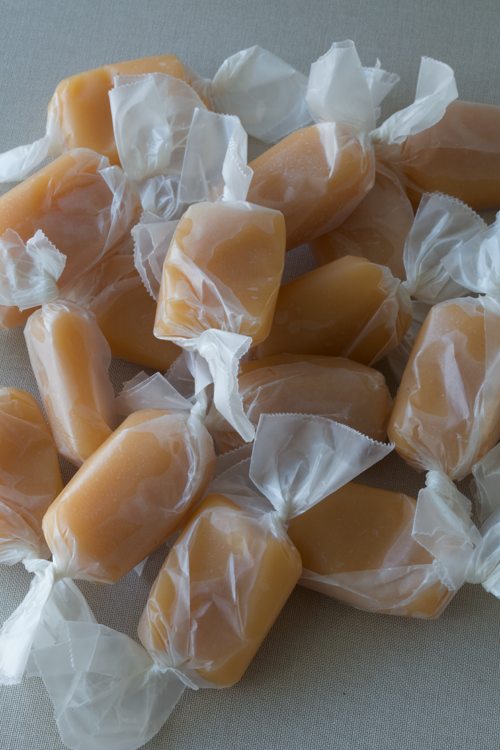



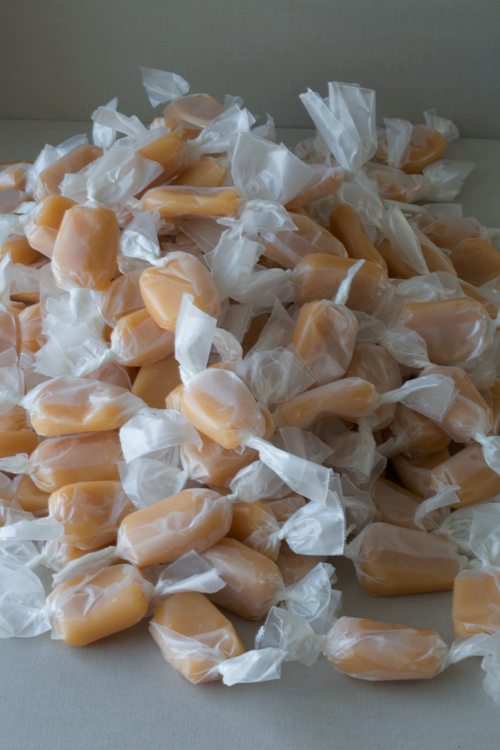
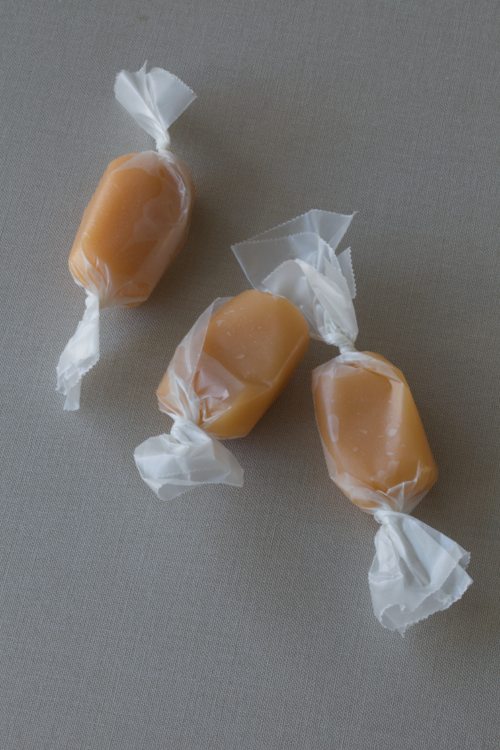
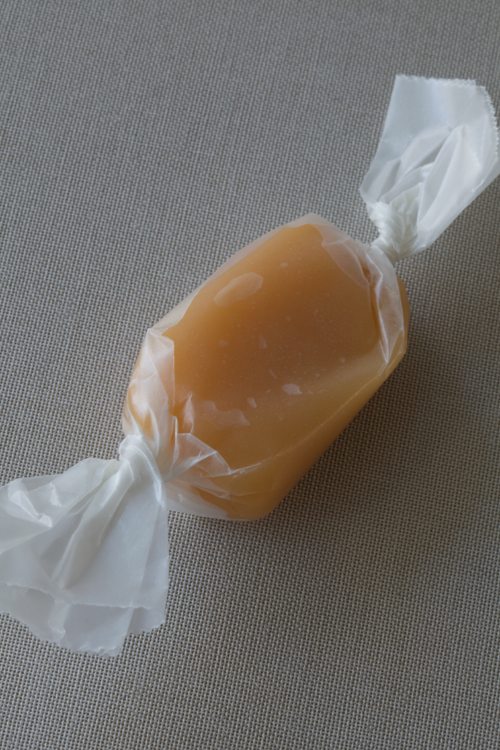
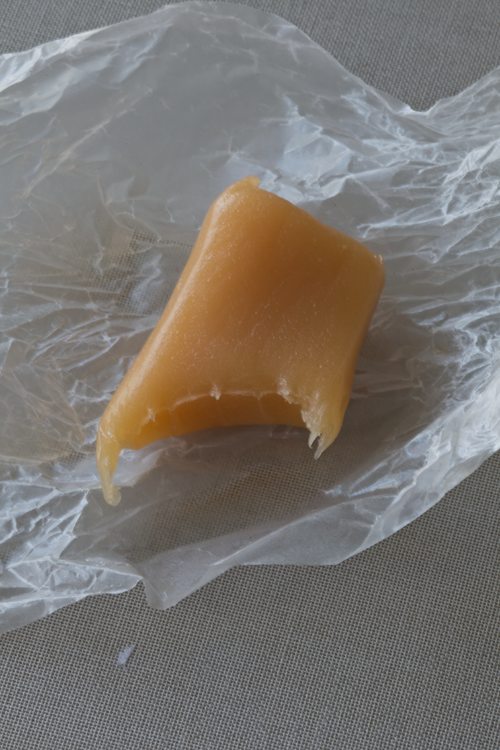



















{ 7 comments… read them below or add one }
Carmels made with love!
Hi,
I was wondering. Is it 240F or C? I think Fahrenheit, but just to be sure I thought I’d ask…
They look yummie and I really want to try them!
With love,
S.
Sheila,
Yes, Fahrenheit! I hope you enjoy them.
Could I use something besides corn syrup?
Liz,
I have only used corn syrup in the recipe. You might be able to substitute 1 cup of sugar dissolved in 1/4 cup of water per cup of corn syrup.
These were sooooooo amazing! I used Trader Joe’s soy creamer in place of the heavy cream and Earth Balance in place of the butter. Perfection! Thank you so much for sharing. This is most definitely a keeper.
Aimee, thank you for letting me know that the substitutions worked so beautifully. Wonderful!